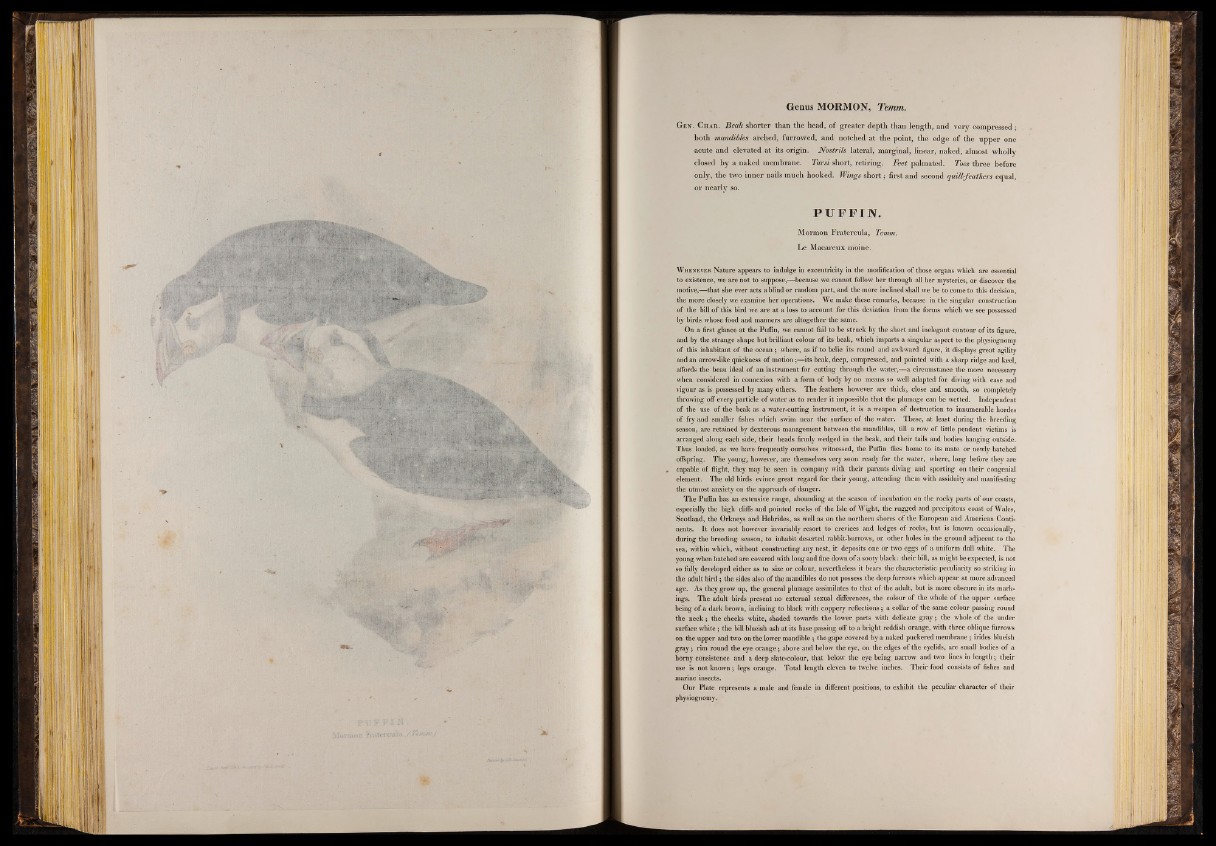
ill
G e n . C h a r . Beak sh o rte r th an th e head, o f g r e a te r d e p th th an len g th , an d v e ry com p re s sed ;
b o th mandibles arch ed , fu rrow ed , a n d n o tch ed a t th e p o in t, th e edge o f th e u p p e r one
acu te a n d elevated a t its origin. Nostrils late ra l, m arginal, lin e a r, naked, almost wh o lly
closed b y a n a k e d membrane. Tarsi sh o rt, re tirin g . Feet p almated. Toes th re e before
o n ly , th e tw o in n e r nails much hooked. Wings s h o rt; first and second quill-feathers equal,
o r n e a rly so.
PU F F IN.
M o rm o n F ra te rcu la , Temm.
L e M a ca re u x moine.
W h e n e v e r Nature appears to indulge in excentricity in the modification of those organs which are essential
to existence, we are not to suppose,— because we cannot follow her through all her mysteries, or discover the
motive,— that she ever acts a blind or random part, and the more inclined shall we be to come to this decision,
the more closely we examine her operations. We make these remarks, because in the singular construction
of the bill of this bird we are at a loss to account for this deviation from the forms which we see possessed
by birds whose food and manners are altogether the same.
On a first glance at the Puffin, we cannot fail to be struck by the short and inelegant contour of its figure,
and by the strange shape but brilliant colour of its beak, which imparts a singular aspect to the physiognomy
of this inhabitant o f the ocean; where, as if to belie its round and awkward figure, it displays great agility
and an arrow-like quickness of motion;—its beak, deep, compressed, and pointed with a sharp ridge and keel,
affords the beau ideal of an instrument for cutting through the water,— a circumstance the more necessary
when considered in connexion with a form of body by no means so well adapted for diving with ease and
vigour as is possessed by many others. The feathers however are thick, close and smooth, so completely
throwing off every particle of water as to render it impossible that the plumage can be wetted. Independent
of the use of the beak as a water-cutting instrument, it is a weapon of destruction to innumerable hordes
of fry and smaller fishes which swim near the surface of the water. These, at least during the breeding
season, are retained by dexterous management between the mandibles, till a row o f little pendent victims is
arranged along each side, their heads firmly wedged in the beak, and their tails and bodies hanging outside.
Thus loaded, as we have frequently ourselves witnessed, the Puffin flies home to its mate or newly hatched
offspring. The young, however, are themselves very soon ready for the water, where, long before they are
capable of flight, they may be seen in company with their parents diving and sporting on their congenial
element. The old birds evince great regard for their young, attending them with assiduity and manifesting
the utmost anxiety on the approach of danger.
The Puffin has an extensive range, abounding at the season o f incubation on the rocky parts of our coasts,
especially the high cliffs and pointed rocks of the Isle of Wight, the rugged and precipitous coast of Wales,
Scotland, the Orkneys and Hebrides, as well as on the northern shores of the European and American Continents.
It does not however invariably resort to crevices and ledges of rocks, but is known occasionally,
during the breeding season, to inhabit deserted rabbit-burrows, or other holes in the ground adjacent to the
sea, within which, without constructing any nest, it deposits one or two eggs o f a uniform dull white. The
young when hatched are covered with long and fine down of a sooty black : their bill, as might be expected, is not
so fully developed either as to size or colour, nevertheless it bears the characteristic peculiarity so striking in
the adult bird; the sides also of the mandibles do not possess the deep furrows which appear at more advanced
age. As they grow up, the general plumage assimilates to that of the adult, but is more obscure in its markings.
The adult birds present no external sexual differences, the colour of the whole of the upper surface
being of a dark brown, inclining to black with coppery reflections; a collar of the same colour passing round
the neck; the cheeks white, shaded towards the lower parts with delicate gray; the whole of the under
surface white; the bill blueish ash at its base passing off to a bright reddish orange, with three oblique furrows
on the upper and two on the lower mandible ; the gape covered by a naked puckered membrane ; irides blueish
gray ; rim round the eye orange; above and below the eye, on the edges of the eyelids, are small bodies of a
horny consistence and a deep slate-colour, that below the eye being narrow and two lines in length; their
use is not known; legs orange. Total length eleven to twelve inches. Their food consists o f fishes and
marine insects.
Our Plate represents a male and female in different positions, to exhibit the peculiar character of their
physiognomy.